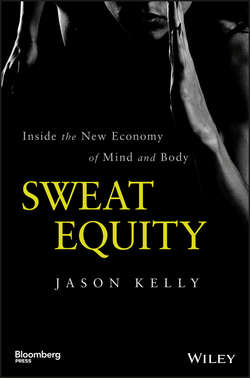Читать книгу Sweat Equity - Jason Kelly - Страница 8
На сайте Литреса книга снята с продажи.
CHAPTER 2
On Location
ОглавлениеIf running is the basic unit of exercise, the gym is the fitness industry’s local headquarters. Walk a few blocks in any city, or drive a few miles in any suburb, and it’s virtually guaranteed you’ll see some sort of fitness chain nestled in a strip mall.
The ubiquity speaks to the gyms’ importance in this fitness economy – for us as consumers, and for those looking to make money in our space. Fitness is front and center, and unashamedly so. Gyms aren’t hidden from you. On the contrary, fitness centers are in the same complexes as supermarkets, shoe stores, dry cleaners, and pizza joints. They’re a key part of our consumer habits.
That’s what excites investors. Just as Moelis’s Kapoor found herself directing more of her discretionary income to her Flywheel habit, even average people are devoting an increasing slice of their cash to sweating. Have any doubts about the competition for that money? Check your mailbox – or email box.
Numbers are somewhat elusive, and largely estimated, given the fragmented nature of fitness clubs; there are so many of them, and few dominant companies to give a cohesive sense of the market. Kapoor estimates that in 2015, clubs will pull in about $27 billion in revenues, a figure that grows steadily these days at around 3 percent a year.
Then there’s the number of memberships, which she estimates at about 55 million, growing at about 2 percent a year. Putting the figures together, that would mean folks spending roughly $500 a year on memberships alone. This triangulates a bit with another oft-cited figure – the average monthly membership is about $55/month, or $660 a year – indicating we’re in the right ballpark.
The traditional gym business did not explode in this most recent boom around fitness and wellness. Many of the current trends and fads have their foundation in the fitness clubs of the previous decades. It’s a business that’s seen its share of booms and busts and constant competition for the consumer. Where it stands today is an emblem of both the fitness economy and the way modern businesses fight for identity and profits.
Kapoor and her fellow bankers watch the gym space closely because it’s, for lack of a better term, investable. The business is relatively simple to model in term of costs, margins, and profits, once the basic elements (geography, products and services, pricing) are established. The gym business in that sense isn’t so different from any other retail concern.
The birth of what we know as the modern gym is generally pegged to the early 1980s, driven in part by a few pop-culture moments. In addition to Jane Fonda’s videos, there was 10, the 1979 Bo Derek movie that inspired many women, and men, to get in shape.
By 1980, according to history compiled by Club Industry, about half the adult population claimed to exercise, up from about 24 percent in 1960.6 Tennis was popular, as was racquetball, and racquet clubs with both kinds of courts proliferated, especially in suburban areas. Over the early part of the 1980s, those clubs expanded their offerings, adding some equipment and classes to broaden their appeal and their membership. In 1981, there were about 5,000 fitness clubs across the United States; by 2012, that number swelled to more than 30,000.7
Clubs like Bally, one of the early stalwarts, advertised heavily, relying on some of the biggest stars of the late 1970s and 1980s, including singer Cher. The ads, available for grainy viewing on YouTube, are fun to watch. A very young Cher, in various combinations of leotards and wigs, strides through a busy fitness center, delivering a message meant to underscore that gyms aren’t just for meatheads anymore. In one ad, released around the holidays in 1985, she starts out saying, “Some people worry about getting muscles. I worry about getting fat. Dieting doesn’t keep me in shape. Exercise does.”
After Cher’s exhortations, the ad lays out the business model that Bally’s helped create and persists among its legion successors in some form today: the monthly plan. Back in 1985, Bally’s would sign you up for $18 a month, assuming you agreed to a two-year contract. That wasn’t exactly dirt cheap – it’s almost $40 in 2015 dollars. The subsequent years have seen all kinds of price wars that have pitted gyms against each other. In the New York area, where nothing is inexpensive, a chain of gyms offers a no-commitment monthly fee of $19.95. Other chains, including discount leader Planet Fitness, charge as little as $10 a month.
Bally’s was onto something and competitors proliferated, creating a sector that stood firmly at the center of the burgeoning fitness economy, for a time.
Fitness centers are a sector of the business where private equity has long played, owing largely to the business model advertised by Cher and her cohorts, from the 1980s on. At its core, the business has a lot of what an investor is looking for, especially one of the private equity variety. The key is predictable cash flow.
A gym that signs its members up for long-term contracts has a clear picture of its business. Its costs – rent, salaries for staff and instructors, equipment, and maintenance – are effectively fixed. With those contracts in hand, the gym operator also knows the revenue side, with very little downside risk. Once a contract is signed, the member is obligated to pay the monthly fee, or face a stiff penalty that’s designed to recoup enough of the money owed to make it hurt the member. Plus, that penalty can be easily modeled into the gym’s business plan.
Конец ознакомительного фрагмента. Купить книгу
6
Pamela Kufahl, “Club Industry Features Clubs of the 1980s,” Club Industry, December 1, 2008, http://clubindustry.com/25th-anniversary/club-industry-features-clubs-1980s.
7
International Health, Racquet, & Sportsclub Association, www.ihrsa.org/about-the-industry/.
